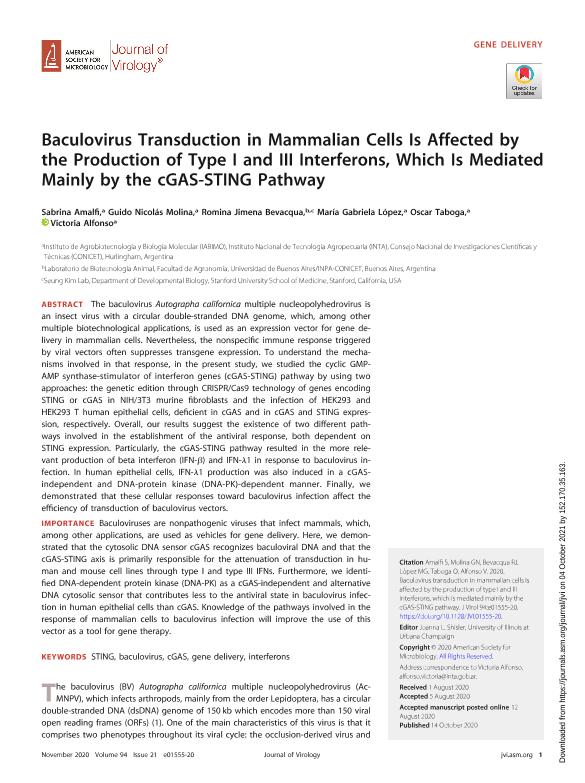Artículo
Baculovirus Transduction in Mammalian Cells Is Affected by the Production of Type I and III Interferons, Which Is Mediated Mainly by the cGAS-STING Pathway
Amalfi, Sabrina ; Molina, Guido Nicolás
; Molina, Guido Nicolás ; Bevacqua, Romina Jimena
; Bevacqua, Romina Jimena ; López, María Gabriela
; López, María Gabriela ; Taboga, Oscar Alberto
; Taboga, Oscar Alberto ; Alfonso, Victoria
; Alfonso, Victoria
 ; Molina, Guido Nicolás
; Molina, Guido Nicolás ; Bevacqua, Romina Jimena
; Bevacqua, Romina Jimena ; López, María Gabriela
; López, María Gabriela ; Taboga, Oscar Alberto
; Taboga, Oscar Alberto ; Alfonso, Victoria
; Alfonso, Victoria
Fecha de publicación:
10/2020
Editorial:
American Society for Microbiology
Revista:
Journal of Virology
ISSN:
0022-538X
Idioma:
Inglés
Tipo de recurso:
Artículo publicado
Clasificación temática:
Resumen
The baculovirus Autographa californica multiple nucleopolyhedrovirus is an insect virus with a circular double-stranded DNA genome, which, among other multiple biotechnological applications, is used as an expression vector for gene delivery in mammalian cells. Nevertheless, the nonspecific immune response triggered by viral vectors often suppresses transgene expression. To understand the mechanisms involved in that response, in the present study, we studied the cyclic GMP-AMP synthase-stimulator of interferon genes (cGAS-STING) pathway by using two approaches: the genetic edition through CRISPR/Cas9 technology of genes encoding STING or cGAS in NIH/3T3 murine fibroblasts and the infection of HEK293 and HEK293 T human epithelial cells, deficient in cGAS and in cGAS and STING expression, respectively. Overall, our results suggest the existence of two different pathways involved in the establishment of the antiviral response, both dependent on STING expression. Particularly, the cGAS-STING pathway resulted in the more relevant production of beta interferon (IFN-β) and IFN-λ1 in response to baculovirus infection. In human epithelial cells, IFN-λ1 production was also induced in a cGAS-independent and DNA-protein kinase (DNA-PK)-dependent manner. Finally, we demonstrated that these cellular responses toward baculovirus infection affect the efficiency of transduction of baculovirus vectors. IMPORTANCE Baculoviruses are nonpathogenic viruses that infect mammals, which, among other applications, are used as vehicles for gene delivery. Here, we demonstrated that the cytosolic DNA sensor cGAS recognizes baculoviral DNA and that the cGAS-STING axis is primarily responsible for the attenuation of transduction in human and mouse cell lines through type I and type III IFNs. Furthermore, we identified DNA-dependent protein kinase (DNA-PK) as a cGAS-independent and alternative DNA cytosolic sensor that contributes less to the antiviral state in baculovirus infection in human epithelial cells than cGAS. Knowledge of the pathways involved in the response of mammalian cells to baculovirus infection will improve the use of this vector as a tool for gene therapy.
Palabras clave:
BACULOVIRUS
,
CGAS
,
GENE DELIVERY
,
INTERFERONS
,
STING
Archivos asociados
Licencia
Identificadores
Colecciones
Articulos (IABIMO)
Articulos de INSTITUTO DE AGROBIOTECNOLOGIA Y BIOLOGIA MOLECULAR
Articulos de INSTITUTO DE AGROBIOTECNOLOGIA Y BIOLOGIA MOLECULAR
Articulos(INPA)
Articulos de UNIDAD EJECUTORA DE INVESTIGACIONES EN PRODUCCION ANIMAL
Articulos de UNIDAD EJECUTORA DE INVESTIGACIONES EN PRODUCCION ANIMAL
Citación
Amalfi, Sabrina; Molina, Guido Nicolás; Bevacqua, Romina Jimena; López, María Gabriela; Taboga, Oscar Alberto; et al.; Baculovirus Transduction in Mammalian Cells Is Affected by the Production of Type I and III Interferons, Which Is Mediated Mainly by the cGAS-STING Pathway; American Society for Microbiology; Journal of Virology; 94; 21; 10-2020; 1-16
Compartir
Altmétricas



